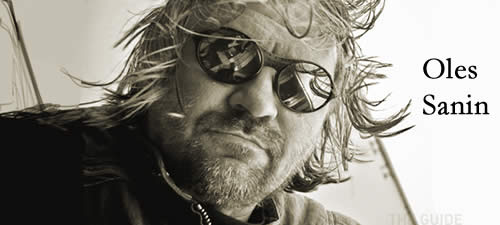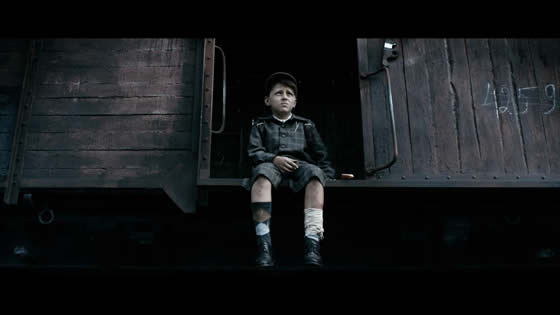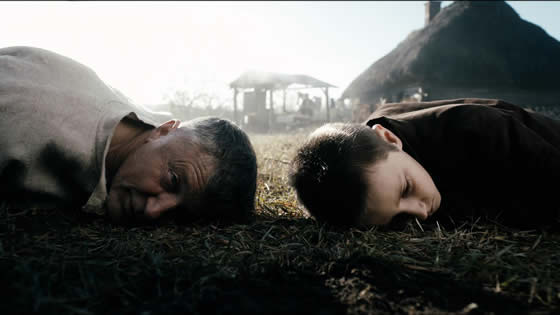The Guide is official entry from Ukraine for foreign language at the 87th Academy.
Set in Soviet Ukraine in the 1903’s at the time of industrialization and forced collectivization, the Great Soviet Famine and the Great Purge when Stalin was determined to crush all vestiges of Ukrainian nationalisman, the untroubled life of Peter Shamrock, an American specialist’s son, changes in a moment when his father is killed. Peter is saved from persecutors by a miracle that comes in the form of a kobzar (blind minstrel), Ivan Kocherga. The boy becomes the kobzar’s guide, and their journey is a powerful and beautiful story of human courage in the face of some of the hardest times in Ukrainian history.
Many of the kobzars in film are played by real blind people from various part of the Ukraine. Some of the fight scenes demonstrate the use of the ‘crutch’ – the art of self-defense that was used by blind minstrels in olden times.
Oles Sanin is a Ukrainian film director, actor and producer. He headed the Department of film and television projects international organization “Internews-Ukraine” and worked as a director at the Dovzhenko film studios and “Ukrkinokhronika”. His film, “Mamay” was Ukraine’s official entry for the Academy Awards nomination in the best foreign language film category in 2004. He holds the State Oleksandr Dovzhenko Prize of Ukraine for “Mamay,” the “Silver medal” of the Academy of Arts of Ukraine and the Lumiere Brothers “Silver  medal”.
medal”.
Sanin plays the bandura and torban and continues the Volyn lyre tradition. He used to make musical instruments, which is a craft he inherited from his grandfather. A kobzar himself, Sanin’s inspiration for the film came from when he served as a guide for a blind minstrel.
Cinema Without Borders: How did you come up with the idea of making The Guide?
Oles Sanin: Ever since I was little I knew the legendary story of the Stalinist regime liquidating the Kobzars, blind minstrels who sang their songs of freedom and independence since the Middle Ages. I play ancient Ukrainian musical instruments myself and sing the songs that once were banned. But an inspiration to make a film about painful events of 1930’s Ukraine came from a great Oscar-winning American actor Jack Palance, whose real name was Volodymyr Palahniuk. The message of a film is that you can kill people, but you cannot kill a song about freedom. I met Jack Palance in 2004, he wanted to star in the film. Unfortunately it was too late. Jack went to a better world, but his energy and his ideas keep living in The Guide.
CWB: Can you tell us about the research stage in this project?
OS: I studied KGB archives, recorded a lot of interviews with witnesses of that events. Studied psychology and everyday life of blind people. But the most valuable experience I got from people who keep living from making musical instruments and singing epic songs in the streets even today.
 CWB: How challenging was making this film?
CWB: How challenging was making this film?
OS: The first written draft of the script was written in 2004. I was ready to start shooting and received initial funding in 2007. Then the government changed in Ukraine. Investors felt that political course is changing towards Russia and stopped answering calls. Finally, in 2011 we went to the set and made the film in 90 days. But difficulties in fundraising or production are not important to the viewer. It does not matter if it was easy or hard for you. How the viewer sees your movie is the only thing that matters. Everything else is behind the scenes.
CWB: Please tell us about your casting process for The Guide.
OS: Over 2,000 boys from Canada, USA, UK, Australia were in contention for the role of Peter Shamrock. Finally ten days before filming I cast 9 year old Anton Green, who was found in Ann Arbor, Michigan. Blind Kobzar was played by Stanislav Boklan. He is a great actor, starring in a lot of TV films, but this work will be undoubtedly significant both for him and for his viewers.
CWB: Did you do a lot of rehearsals or did you just work with actors and crew on the set?
OS: I love rehearsals, spend a lot of time in conversations with the actors about their characters, motivations and dramatic conflict. But from my experience, there is no substitute to the work at the set in front of the camera. I don’t grudge time for actors on the set. I make as many takes as needed to achieve the desired result.
CWB: Did you allow any improvisations proposed by your cast or crew?
OS: I usually do a lot of storyboards and planning. But I like to create a set that not only shows the best interior or landscape, but allows the camera to improvise together with actor and find the angle and shot, which best reveals the essence of the episode and helps the actor. Many scenes were changed during filming. I hope for the best.
CWB: How did you come up with the visual style of your film?
OS: Together with DoP Sergiy Mykhalchuk we recreated the world of ‘30s. We worked hard to shoot an epic story. We searched for a very special locations. For a way not only to reflect the era, but also to tell the world of our characters. We visualized the world of the blind. “Super-close-up” shots and textures at arm’s length allow the viewer literally “to palp” the picture, as blind people do. And wide shots had to have very active audible nature, of the world rather imaginary than real. Because blind people imagine the world around them. It’s a world that does not get old.
CWB: How much of film found its final form in the editing process?
OS: Film is a living matter for me. I think editing has to transform the footage into emotional story. Film is not only the visual adaptation of the script text. Cinema is somewhat of a dream. The second part of my film has a lot of spontaneous moments. It emerged only at the editing timeline.
CWB: Please tell us about the critics and audience responses to The Guide.
OS: Critics always have a dissenting opinion. Some write panegyrics, others express themselves in the style of obituaries. Uncompromising battles are rising online and on newspaper pages. This time I didn’t manage to slip unnoticed. This is caused also by the fact that the film has had unprecedented success domestically. The numbers of admissions and box office broke all possible records in Ukraine. On the one hand it inspires, on the other it makes you more accountable with your next film.
CWB: Any future project that you can tell us about?
OS: My next project will definitely be international. I want to make films in co-production with Europe and the United States. And I already have several projects in development. Not to stop. To believe in oneself. To work and amaze.

